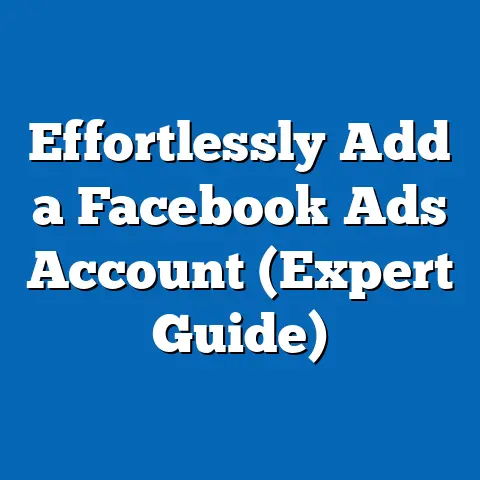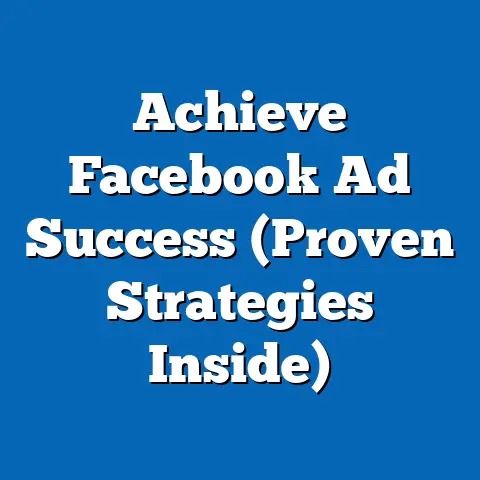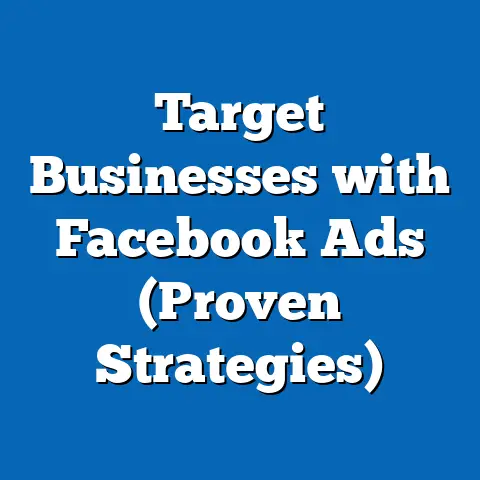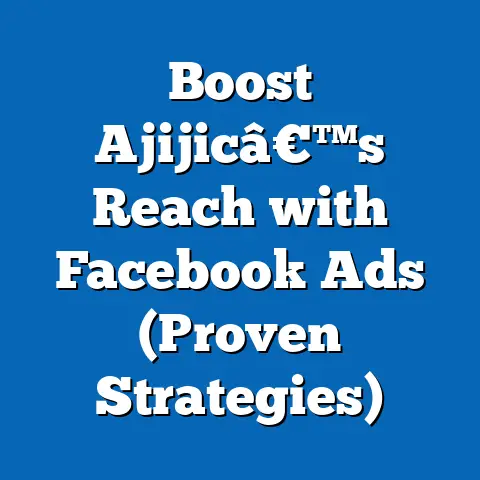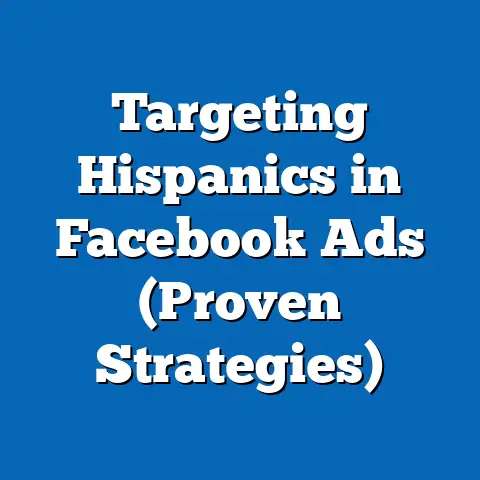Master the Facebook Ad Auction Process (Insider Secrets Revealed)
Understanding the Facebook Ad Auction
The Facebook ad auction is the system Facebook uses to determine which ads get shown to users. Think of it as a real-time bidding war, happening millions of times every second. It’s the engine that powers Facebook’s advertising ecosystem, deciding who sees what, and when. Without this system, your ads would be randomly displayed, leading to irrelevant placements and wasted spend.
Facebook doesn’t just pick the highest bidder. It’s a more sophisticated process that considers multiple factors to ensure users have a positive experience while advertisers get the most value. The goal is to balance advertiser goals with user experience.
There are three main components that influence the auction:
- Bid: How much you’re willing to pay to show your ad.
- Estimated Action Rates: Facebook’s prediction of how likely users are to engage with your ad (e.g., click, convert).
- Ad Quality & Relevance: How relevant and high-quality your ad is to the target audience.
These factors work together to determine an ad’s placement. Facebook combines these elements to calculate a “total value,” and the ad with the highest total value wins the auction, securing the ad placement.
Key Takeaway: The Facebook ad auction isn’t just about having the biggest budget. It’s about understanding the system and optimizing your ads to deliver the most value.
The Components of the Auction
Let’s break down each component of the Facebook ad auction in more detail. This is where the rubber meets the road, and understanding these elements is crucial for optimizing your campaigns.
Bidding Strategy
Your bidding strategy dictates how Facebook spends your budget to achieve your desired results. Facebook offers several bidding strategies, each designed for different goals. Choosing the right strategy is essential for success. I’ve seen campaigns skyrocket or plummet based solely on the bidding strategy used.
Here are a few common bidding strategies:
- Lowest Cost: This strategy aims to get the most results for your budget. Facebook automatically bids in auctions to get the lowest possible cost per result. It’s great for beginners or when you don’t have a specific cost target.
- Cost Cap: This strategy aims to keep your average cost per result around a target amount. Facebook will bid in auctions to achieve this, but may not spend your entire budget if costs are higher than your cap.
- Bid Cap: This allows you to manually set the maximum bid Facebook can use in any given auction. It gives you more control but requires careful monitoring and adjustment.
- Value Optimization: If you’re tracking revenue or value from your conversions, this strategy helps you get the highest return on ad spend (ROAS).
Why it Matters: The bidding strategy you choose directly impacts your auction participation and the costs you incur. If you’re aiming for conversions, using a “Lowest Cost” strategy might be a good starting point, but as you gather data, transitioning to a “Cost Cap” or “Value Optimization” strategy can improve efficiency.
Next Step: Experiment with different bidding strategies to see which one performs best for your specific goals. Monitor your results closely and adjust as needed.
Estimated Action Rate
The Estimated Action Rate is Facebook’s prediction of how likely a user is to take your desired action, whether it’s clicking on your ad, watching a video, or making a purchase. This prediction is based on a multitude of factors, including the user’s past behavior, the ad’s relevance, and the historical performance of similar ads.
Facebook uses machine learning algorithms to analyze vast amounts of data and predict user behavior. The higher the estimated action rate, the more favorably Facebook views your ad in the auction. A high estimated action rate can lower your costs and improve your ad placement.
How to Improve Your Estimated Action Rate:
- Targeting: Ensure your ads are shown to the most relevant audience. Use Facebook’s detailed targeting options to narrow down your audience based on demographics, interests, and behaviors.
- Ad Relevance: Create ads that resonate with your target audience. Use compelling visuals and persuasive copy that speaks to their needs and interests.
- Landing Page Experience: Make sure your landing page is optimized for conversions. It should be relevant to your ad, easy to navigate, and mobile-friendly.
Why it Matters: A higher estimated action rate not only improves your ad placement but also reduces your costs. Facebook rewards ads that are likely to generate positive user engagement.
Next Step: Review your targeting settings and ad creatives. Are you reaching the right audience with the right message? Optimize your landing page for a seamless user experience.
Ad Quality and Relevance
Ad quality and relevance play a crucial role in the Facebook ad auction. Facebook wants to show users ads that are engaging, informative, and relevant to their interests. Ads that provide a positive user experience are rewarded with better placement and lower costs.
Facebook assesses ad quality based on several factors, including:
- Relevance Score: This score, on a scale of 1 to 10, indicates how relevant your ad is to the target audience. A higher score means your ad is more relevant.
- Feedback: Negative feedback, such as users hiding or reporting your ad, negatively impacts your ad quality.
- Post-Click Experience: If users quickly leave your landing page after clicking your ad, it signals a poor post-click experience and can hurt your ad quality.
How to Improve Ad Quality and Relevance:
- Audience Alignment: Ensure your ad is shown to the right audience. Use precise targeting and create ads that speak to their specific needs and interests.
- Compelling Creatives: Use high-quality visuals and persuasive copy that grabs attention and resonates with your audience.
- Clear Value Proposition: Clearly communicate the value you offer in your ad. What problem do you solve? What benefits do you provide?
- A/B Testing: Continuously test different ad creatives and targeting options to find what works best.
Why it Matters: Ad quality and relevance directly impact your ad costs and placement. Facebook prioritizes ads that provide a positive user experience, rewarding them with better results.
Next Step: Analyze your ad performance metrics and identify ads with low relevance scores. Experiment with different creatives and targeting options to improve ad quality.
Insider Secrets to Winning the Auction
Now that we’ve covered the fundamentals, let’s dive into some insider secrets that can give you a competitive edge in the Facebook ad auction. These are strategies I’ve personally used to achieve significant results for my clients.
Secret 1: Optimize Your Targeting
Precise targeting is the cornerstone of successful Facebook advertising. The more accurately you can identify and reach your ideal audience, the higher your estimated action rate will be.
Facebook offers a wealth of targeting options, including:
- Demographics: Target users based on age, gender, education, and other demographic factors.
- Interests: Reach users based on their interests, hobbies, and pages they’ve liked.
- Behaviors: Target users based on their online behavior, such as purchase history and device usage.
- Custom Audiences: Create custom audiences based on your existing customer data, website visitors, and app users.
- Lookalike Audiences: Expand your reach by targeting users who are similar to your existing customers.
Actionable Tip: Don’t rely solely on broad targeting. Use a combination of demographic, interest, and behavior targeting to narrow down your audience. Create custom and lookalike audiences to reach your most valuable prospects.
Personal Experience: I once worked with an e-commerce client who was struggling with low conversion rates. By creating a lookalike audience based on their existing customers and targeting them with personalized ads, we saw a 3x increase in conversion rates within a month.
Next Step: Review your current targeting settings and identify opportunities for improvement. Experiment with different targeting options and create custom and lookalike audiences.
Secret 2: Crafting Compelling Ad Creatives
High-quality visuals and persuasive copy are essential for capturing attention and driving engagement. Your ad creative is the first thing users see, so it needs to be compelling enough to make them stop scrolling.
Here are some tips for crafting effective ad creatives:
- Use High-Quality Images and Videos: Avoid blurry or low-resolution images. Use professional-quality visuals that showcase your product or service in the best light.
- Write Persuasive Copy: Clearly communicate the value you offer and address the needs and interests of your target audience. Use a strong call to action to encourage users to take the desired action.
- A/B Testing: Continuously test different ad creatives to find what works best. Experiment with different headlines, images, and call-to-action buttons.
- Mobile Optimization: Ensure your ad creatives are optimized for mobile devices. Most Facebook users access the platform on their smartphones, so your ads need to look great on smaller screens.
Actionable Tip: Use A/B testing to continuously optimize your ad creatives. Test different headlines, images, and call-to-action buttons to find what resonates best with your audience.
Personal Experience: I once ran an A/B test for a client, comparing two different ad images. One image featured the product in a studio setting, while the other showed the product being used in a real-life scenario. The real-life image outperformed the studio image by 40%, demonstrating the power of relatable visuals.
Next Step: Review your current ad creatives and identify opportunities for improvement. Experiment with different images, headlines, and call-to-action buttons.
Secret 3: Timing is Everything
The time of day and seasonality can significantly impact ad performance and auction dynamics. Understanding when your target audience is most active and receptive to your message can help you optimize your ad scheduling and improve your results.
Here are some factors to consider:
- Time of Day: Analyze your ad performance data to identify the times of day when your ads generate the most engagement and conversions. Schedule your ads to run during these peak hours.
- Day of the Week: Certain days of the week may be more effective for your ads than others. Experiment with different ad scheduling and analyze your results.
- Seasonality: Consider the time of year and any relevant holidays or events. Create ads that are tailored to the current season and target audience.
Actionable Tip: Use Facebook’s ad scheduling feature to run your ads during peak hours. Analyze your ad performance data to identify the most effective times of day and days of the week.
Personal Experience: I once worked with a restaurant client who saw a significant increase in reservations by scheduling their ads to run during lunchtime and dinnertime. By targeting users who were likely to be hungry and looking for a place to eat, we were able to drive a surge in bookings.
Next Step: Analyze your ad performance data to identify peak hours and days. Schedule your ads to run during these times and create ads that are tailored to the current season.
Secret 4: Leverage Facebook’s Algorithm
Understanding and utilizing Facebook’s algorithm can significantly improve your ad performance. The algorithm is constantly learning and adapting, so it’s important to stay up-to-date on the latest changes and best practices.
Here are some ways to leverage Facebook’s algorithm:
- Engagement Metrics: Focus on driving engagement with your ads. The more likes, comments, and shares your ads generate, the more favorably Facebook will view them.
- Relevance Score: Aim for a high relevance score. This indicates that your ad is relevant to the target audience and provides a positive user experience.
- Conversion Tracking: Set up conversion tracking to accurately measure the results of your ads. This will help Facebook optimize your campaigns for conversions.
- Campaign Budget Optimization (CBO): Use CBO to allow Facebook to automatically allocate your budget across your ad sets. This can help you get the most results for your budget.
Actionable Tip: Focus on driving engagement with your ads. Ask questions, encourage comments, and create ads that are shareable and informative.
Personal Experience: I once worked with a non-profit client who saw a significant increase in donations by creating ads that told compelling stories and encouraged users to share their own experiences. By focusing on engagement, we were able to reach a wider audience and drive more donations.
Next Step: Review your ad performance metrics and identify opportunities to improve engagement. Set up conversion tracking and experiment with CBO.
Secret 5: Continuous Monitoring and Adjustment
Ongoing campaign optimization is crucial for success. The Facebook ad auction is dynamic, so it’s important to continuously monitor your results and adjust your strategies as needed.
Here are some things to monitor:
- Ad Performance: Track your key performance indicators (KPIs), such as impressions, clicks, conversions, and cost per result.
- Auction Insights: Use Facebook’s auction insights tool to see how you’re performing against your competitors.
- Audience Overlap: Monitor your audience overlap to avoid targeting the same users with multiple ads.
- Ad Fatigue: Watch out for ad fatigue, which occurs when users become tired of seeing the same ads.
Actionable Tip: Set up regular reporting and analysis to track your ad performance. Use the insights you gain to optimize your campaigns and improve your results.
Personal Experience: I once worked with a client who was experiencing ad fatigue. By refreshing their ad creatives and targeting a new audience, we were able to revitalize their campaign and drive a surge in conversions.
Next Step: Set up regular reporting and analysis to track your ad performance. Use the insights you gain to optimize your campaigns and improve your results.
Common Pitfalls to Avoid
Even with the best strategies, it’s easy to make mistakes in the Facebook ad auction. Here are some common pitfalls to avoid:
- Setting Unrealistic Bids: Bidding too low can result in your ads not being shown, while bidding too high can waste your budget.
- Neglecting Ad Quality: Ignoring ad quality can result in poor placement and higher costs.
- Failing to Test Different Strategies: Not testing different creatives, targeting options, and bidding strategies can leave you missing out on potential improvements.
- Ignoring Data: Failing to analyze your ad performance data can lead to missed opportunities and wasted spend.
Actionable Tip: Avoid these pitfalls by setting realistic bids, focusing on ad quality, testing different strategies, and continuously monitoring your results.
Personal Experience: I once saw a client waste a significant portion of their budget by setting unrealistic bids. By adjusting their bidding strategy and focusing on ad quality, we were able to significantly improve their results.
Next Step: Review your current strategies and identify any potential pitfalls. Make adjustments as needed to avoid these common mistakes.
Conclusion
Mastering the Facebook ad auction process is crucial for any business aiming to succeed in the competitive landscape of Facebook advertising. By understanding the mechanics of the auction, optimizing your targeting, crafting compelling ad creatives, and continuously monitoring your results, you can significantly improve your ad performance and achieve a better ROI.
I’ve shared insider secrets that I’ve personally used to achieve significant results for my clients. Take action on these strategies and start optimizing your Facebook ad campaigns today. Remember, understanding the auction mechanics is not just about having a bigger budget, it’s about working smarter and delivering the most value to your target audience.
Good luck, and happy advertising!

